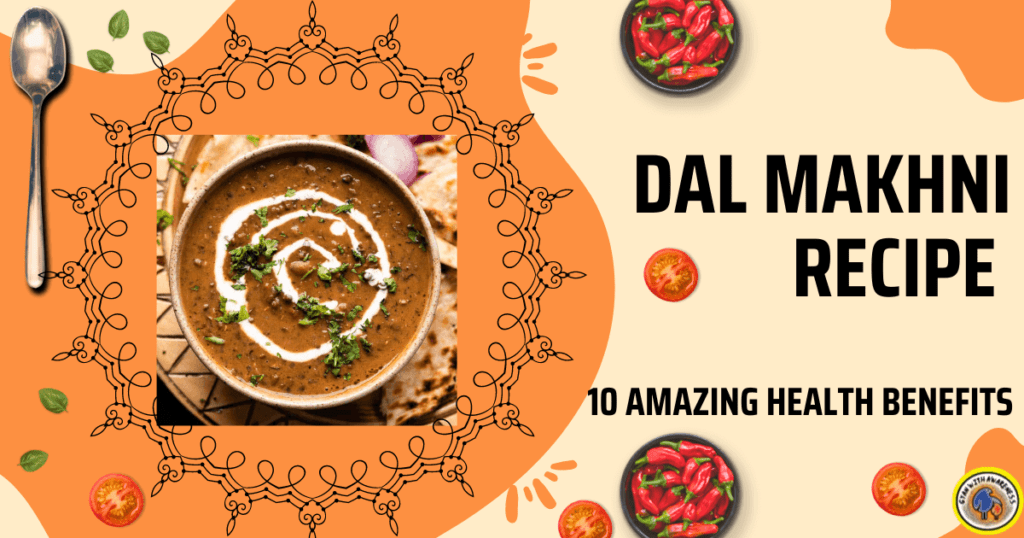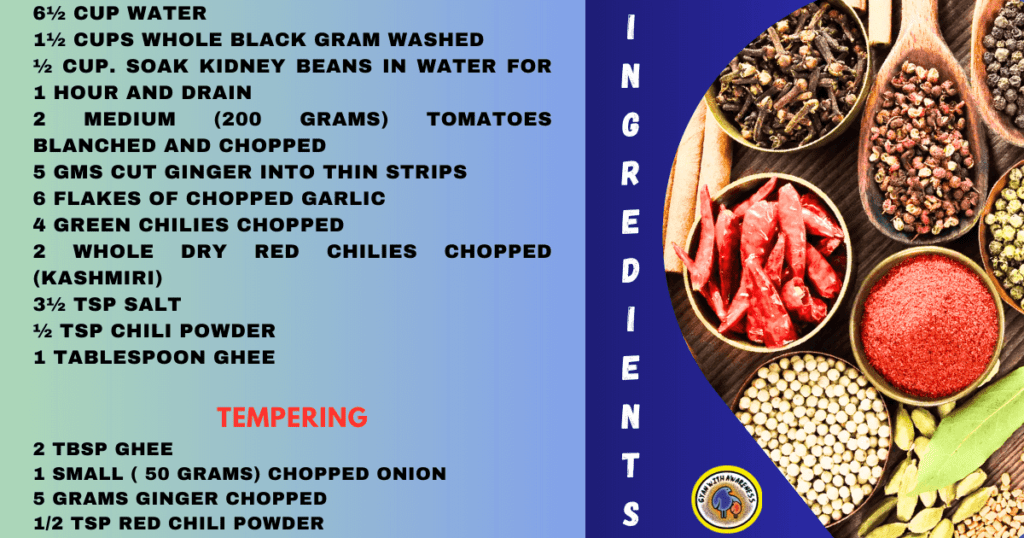Dal Makhni: A Delectable Fusion of Flavor, Heritage, and Wellness!
Dal Makhni, a timeless culinary gem originating from North India, tantalizes taste buds with its rich and velvety texture, creating an unforgettable experience on the palate. This traditional dish, dating back centuries, harmoniously blends lentils and kidney beans simmered in a luscious blend of aromatic spices, butter, and cream. The result is a symphony of flavors that dance across the tongue, leaving an indelible mark on those fortunate enough to indulge.
Hailing from the fertile regions of Punjab, Dal Makhani’s roots can be traced to the kitchens of rural households and Punjabi dhabas. It embodies the essence of Indian culture and hospitality, offering a connection to history with every spoonful.
The healthy and adaptable legume Dal Makhni, sometimes called whole black gram, has a long history and is frequently used in Indian cooking. It is thought to have its roots in the Indian subcontinent, specifically in the country’s northern areas. This robust legume has a special position in Indian culinary traditions and is a main ingredient in many classic dishes.

When it comes to taste, Dal Makhni offers a unique and earthy flavor. It has a robust and nutty profile with a slightly creamy texture. The dal is often cooked until tender and seasoned with a blend of aromatic spices, enhancing its taste and aroma. Whether prepared as a simple dal dish or as part of more complex recipes, Dal Makhni adds depth and richness to various Indian dishes.
In the northern states of India, such as Punjab, Uttar Pradesh, and Haryana, dal makhni is frequently consumed. These areas have a long history of farming, and Maki Dal flourishes in their rich soils. It is a crucial component of well-known meals like Dal Makhani, a decadent and creamy lentil dish that is a national favorite.
The versatility, nutritional value, and delightful taste of Maki Dal have made it a beloved ingredient in Indian households. Whether it’s a comforting bowl of dal or a spicy curry, Maki Dal continues to be an integral part of Indian cuisine, delighting taste buds and providing a wholesome dining experience.
Dal Makhni Health Benefits:
1. Rich Source of Plant-Based Protein: Dal Makhni is abundant in lentils and kidney beans, providing a substantial plant-based protein source vital for muscle repair and overall growth.
2. High Fiber Content: The dish’s fiber content aids in digestion, regulates bowel movements, and contributes to a feeling of fullness, supporting weight management.
3. Low Glycemic Index: The combination of lentils and beans results in a low glycemic index, helping to maintain steady blood sugar levels, making it suitable for diabetics.
4. Nutrient-Rich: Dal Makhni is brimming with essential nutrients like iron, folate, magnesium, and potassium, which contribute to optimal bodily functions.
5. Spices with antioxidant properties include cumin and turmeric, which protect against oxidative stress and advance general health.
6. Weight management: The presence of protein and fiber promotes satiety and curbs overeating.
7. Heart Health: Its components’ soluble fiber can help reduce levels of bad cholesterol and reduce the risk of heart disease.
8. Constipation prevention, gut health promotion, and maintenance of a healthy digestive tract are all attributes of lentils and beans.
9. Complete protein is produced when lentils are combined with grains (such as rice), providing a balanced nutritional profile.
10. Vitamins and minerals are abundant in the dish’s spices and seasonings, which support healthy bones, stronger immune systems, and beautiful skin.
Beyond its remarkable taste and cultural significance, Dal Makhani also boasts an array of health benefits. Bursting with plant-based protein, fiber, and essential nutrients, this dish supports digestion, promotes satiety, and aids in maintaining stable blood sugar levels. Its medley of spices, such as cumin, coriander, and turmeric, contribute to its potential anti-inflammatory and antioxidant properties, enhancing overall well-being.
In this exploration, we delve into the wholesome qualities that Dal Makhani brings to the table, celebrating its heritage and its potential to nourish both body and soul.
North Indian Cuisine
Dal Makhni (Whole black gram)
Course: Main Course Diet: Vegetarian
Prepare Time: 10 mins Pressure Cooking Time: 30 mins
Total Time: 40 mins Serves: 10
Nutrition:
Calories 330
Total Fat 19g Saturated Fat 9.9g
Trans Fat 0.6g Polyunsaturated Fat 1.4g
Monounsaturated Fat 6g Cholesterol 44mg
Sodium 372mg Carbohydrates 31g
Dietary Fiber 10g Sugars 4.7g
Protein 13g Potassium 567mg
Ingredients for Dal Makhni:
6½ cup Water
1½ cups whole black gram washed
½ cup. Soak kidney beans in water for 1 hour and DRAIN
2 medium (200 grams) tomatoes blanched and chopped
5 gms cut ginger into thin strips
6 flakes of chopped garlic
4 green chilies chopped
2 whole dry red chilies chopped (Kashmiri)
3½ tsp Salt
½ tsp chili powder
1 tablespoon Ghee
Tempering
2 tbsp Ghee
1 small ( 50 grams) chopped onion
5 grams ginger chopped
1/2 tsp red chili powder

Let’s make tasty Dal Makhni:
1. Pour water into the cooker. Bring to a boil on high heat. Add black gram and all other ingredients except those for tempering. Stir once.
2. Close the cooker. Bring to full pressure on high heat. Reduce heat and cook for 30 minutes.
3. Remove the cooker from heat. Allow cooling naturally
4. Open cooker. Partially mash the dal with the back of a ladle.
5. Place cooker with dal on low heat. Simmer to get a creamy consistency (approximately 7 minutes), stirring occasionally,
6. For tempering, heat ghee in a pan for about 1 minute. Add onion and fry till transparent. Add ginger and continue frying till the onion is golden brown. Remove pan from heat. Add chili powder and pour evenly over the dal. To install Serve hot.
Dal Makhani, a masterpiece of Indian cuisine, delights the senses with its rich and velvety texture. Simmered to perfection, black lentils and kidney beans unite in a harmonious dance of flavors, creating a symphony of indulgence. The robust blend of aromatic spices infuses each bite with warmth and depth, making it a truly heartwarming dish. The lavish use of cream and butter imparts a luscious smoothness that’s truly irresistible. With every spoonful, this culinary gem takes taste buds on an exquisite journey, leaving a lasting impression of comfort and satisfaction. Dal Makhani is more than a dish; it’s a celebration of culinary artistry and joy.

Tips for more taste:
Here are some fantastic tips from my side to enhance your taste bites and give them more flavor in one dish.
Slow Simmering: To enhance the taste of Dal Makhni, allow it to simmer on low heat for an extended period. This slow cooking process lets the flavors meld together, resulting in a more robust and rich taste.
Spice Infusion: Experiment with freshly ground spices like cumin, coriander, and garam masala. Adding them at different stages of cooking enhances the complexity of flavors, giving your Dal Makhni a delightful taste.
Charcoal Infusion: For an authentic touch, try the “dhungar” technique. Place a piece of charcoal in a bowl within the dal pot, heat it until red-hot, and then drizzle ghee or oil over the charcoal. The smoke that arises infuses a unique smokiness, elevating the taste.
Creamy Indulgence: Use a generous amount of cream or butter during the cooking process. This imparts a velvety texture and a luxurious taste, making the dal more indulgent and satisfying.
Marinating Beans: Marinate the black lentils and kidney beans in a mixture of yogurt and spices before cooking. This not only tenderizes the beans but also infuses them with flavors, resulting in a more flavorful dal.
Remember, experimenting with ingredient proportions and techniques allows you to tailor the taste of Dal Makhni to your personal preferences, creating a truly exceptional dish.
Also Read: Delicious: Murgh Musallam with best 10 steps and Its Health Benefits